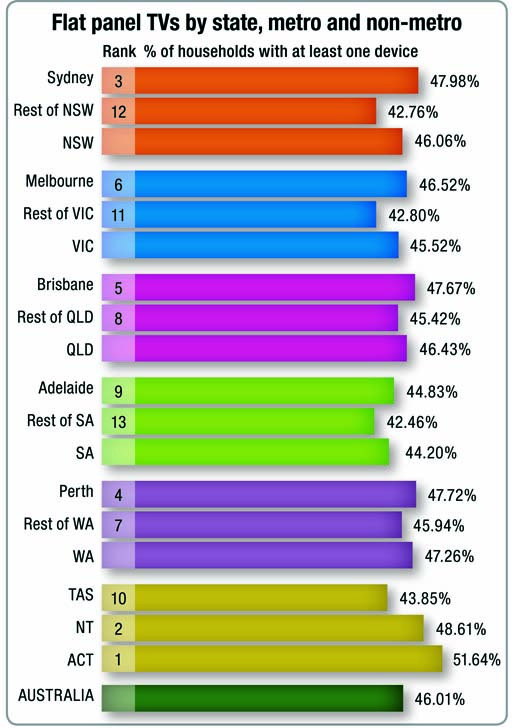Facts and figures: The ‘green’ factor
There’s been a lot of talk recently about ‘green IT’ reducing the energy consumption of information technology systems in organisations.
Computers consume a vast amount of power – as much as 10% of the corporate total in industries such as finance and banking, in which information is the real currency.
That’s all very well in the corporate world, but what about on the domestic front?
ADVERTISEMENT
Many of our homes are now mini data centres. The Connection Research publication Digital Atlas of Australia, which measures household use of digital technology, shows that 82% of households have PCs, and nearly half have two or more.
Digital storage capacity in the typical Australian home is approaching one terabyte, an amount of data once the preserve of large companies and government departments.
And the typical home computer user has to deal with many of the same issues as corporate IT departments: networking, data security, back-up and recovery, and managing peripherals and end-users.
Further, there are many more homes than there are corporate data centres.
The Australian Bureau of Statistics counts about eight million households in Australia, and the Digital Atlas of Australia reports more than 10 million private PCs in use.
Despite the current fad for laptop and notebook PCs, most of these machines are desktops, which consume much more power. There are nearly six million desktop PCs in private use, and more than four million laptops.
Also, LCD screens are much more popular, but many home PCs still use old CRT monitors, which are extremely power-hungry.
Most homes have at least one printer, often the multi-function variety, which is left on all the time – as are networking devices such as modems, switches and routers.
Then there’s the other major digital operation in the household, the TV. Or, as it usually is, TVs.
Again, multiple ownership is the norm. Households on average have 1.7 CRT TVs, and 47% have an LCD or plasma unit. Many of these, particularly the older ones, consume as much energy as a fridge.
The superseded CRT TVs are often retired to the spare room or a kid’s bedroom.
Set-top boxes, games consoles, phone and iPod chargers, DVD players and recorders, amplifiers and powered speaker systems all add to the equation.
All this stuff is digital nowadays, and all devices are usually left on standby power pretty well permanently. Standby power alone adds about 10% to the power consumption of a device.
Add it all up and you have enormous energy consumption and horrendous waste. You can calculate it a number of ways, but in the typical Australian household PCs and peripherals account for about 10% of total electricity consumption, and entertainment devices use 15% or more.
This figure is much higher than it needs to be. Studies by Connection Research and others show that although three-quarters of us profess to be green and worried about global warming, fewer than a quarter make any real effort to reduce household energy consumption.

Households on average have 1.7 CRT TVs, and 47% have an LCD or plasma unit. Many of these, particularly the older ones, consume as much energy as a fridge.
Many of us do active things like switching off lights and air-conditioners a bit more, and taking shorter showers. It feels good because we are doing the right thing.
But only a small proportion of the population habitually turn things off at the wall when not in use, or follow any sort of digital power consumption minimisation scheme.
What should you do? There are three main ways of reducing your home’s digital footprint.
The first, and most obvious, is to get rid of wasteful standby power consumption. Turning things off at the wall may be a hassle, but it is much easier if you set your switching up the right way.
It’s easy to have multiple devices run from one power board, and to switch that off and on as necessary.
One way of doing this involves a great new device from Australian electrical supplier Crest.
The Earth Smart power board automatically turns off peripheral devices when a primary device is turned off.
Switch off your PC normally, and your printer and modem switch off, even from standby mode. Switch off your TV, and your DVD player and amplifier turn off completely. It’s like turning everything off at the wall.
Earth Smart is a great idea, and it also handles power surges and the like. These clever units are being sold at most major electrical retailers. There are two models – for PC systems, and for home entertainment systems.
The second way is to use more power-efficient devices. This is not easy – we can’t easily just ditch what we have and replace it with new gear. But we can move in that direction every time we upgrade, with an eye on energy efficiency every time we buy a new PC, TV or peripheral.
The third way is to simply adopt more intelligent patterns of use. Employ optimal computer power settings, particularly with laptops, which don’t need to draw a lot of power. Don’t use screen savers, and have the screen turn off when the PC hasn’t been used for a while.
Switch the TV off when nobody’s watching it. Don’t print things out unless you have to. Recycle paper. Turn the music down.
Do a Google search on this stuff. There’s lot of advice, and much of it is common sense. But, as they say, common sense isn’t very common.
The green IT revolution sweeping the corporate world has just as much applicability at the domestic level. All homes are data centres, and the same rules apply.
-
ADVERTISEMENT
-
ADVERTISEMENT
-
ADVERTISEMENT
-
ADVERTISEMENT
